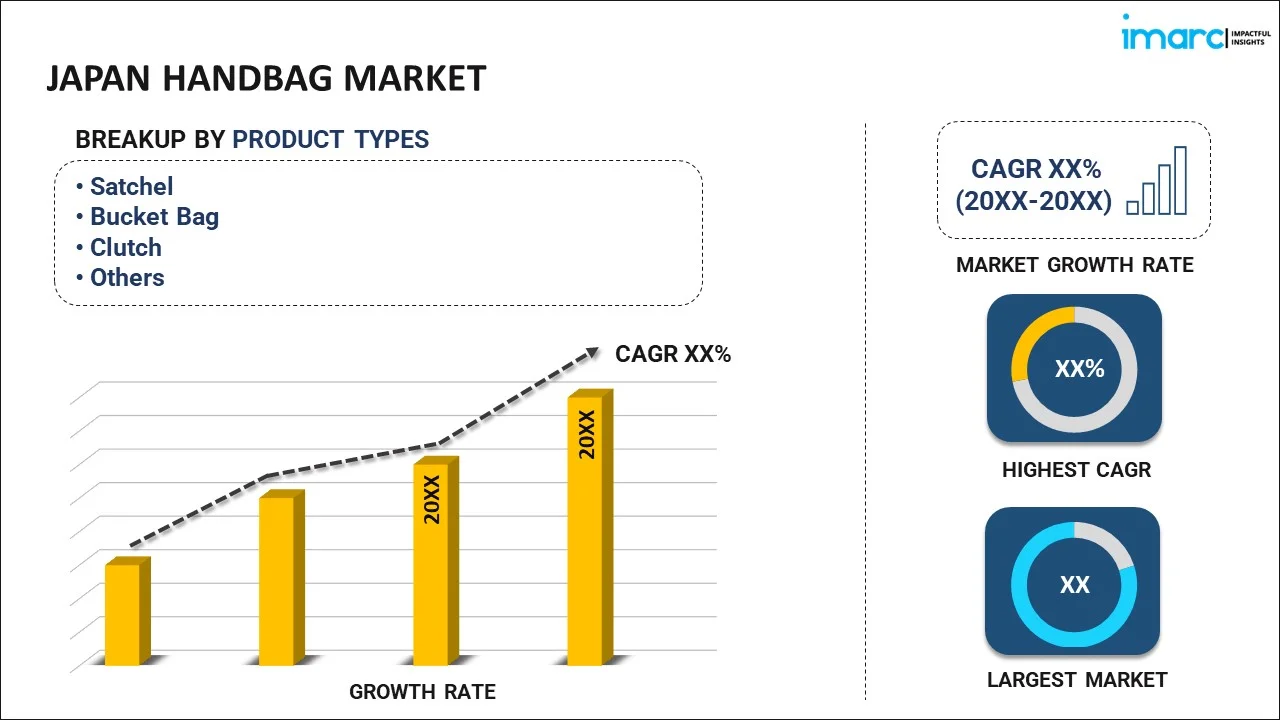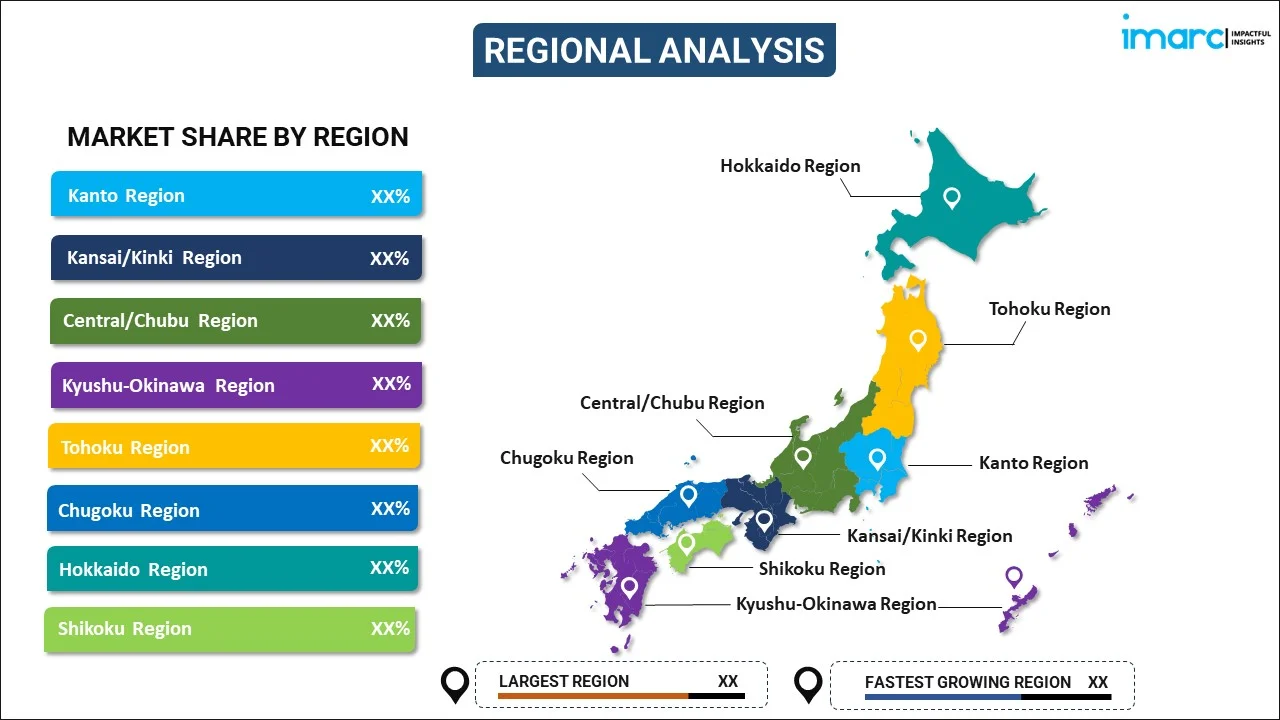
Japan Handbag Market Report by Product Type (Satchel, Bucket Bag, Clutch, Tote Bag, and Others), Material Type (Leather, Fabric, Rubber, and Others), Distribution Channel (Supermarkets and Hypermarkets, Departmental Stores, Specialty Stores, Discount Stores, Online Stores, and Others), and Region 2025-2033
Market Overview:
Japan handbag market size reached USD 1.4 Billion in 2024. Looking forward, IMARC Group expects the market to reach USD 1.9 Billion by 2033, exhibiting a growth rate (CAGR) of 3.3% during 2025-2033. The increasing demand for E-commerce platforms and social media, which have made it easier for consumers to discover and purchase handbags, often at competitive prices, is driving the market.
|
Report Attribute
|
Key Statistics
|
|---|---|
|
Base Year
|
2024 |
|
Forecast Years
|
2025-2033
|
|
Historical Years
|
2019-2024
|
| Market Size in 2024 | USD 1.4 Billion |
| Market Forecast in 2033 | USD 1.9 Billion |
| Market Growth Rate (2025-2033) | 3.3% |
A handbag, also known as a purse or pocketbook, is a fashion accessory designed primarily for carrying personal items such as wallets, keys, makeup, and other essentials. Handbags come in a wide variety of styles, shapes, and sizes, catering to both practical and aesthetic preferences. They have been a part of human culture for centuries, evolving from simple pouches and satchels to intricate and stylish accessories. Handbags are typically made from various materials, including leather, fabric, synthetic materials, and exotic skins, depending on their intended use and design. They often feature straps or handles for easy carrying and secure closures like zippers, snaps, or clasps to protect the contents. Handbags serve as more than just functional items; they are often considered a symbol of style and status. They can complement an outfit, make a fashion statement, and express one's personality. From iconic luxury brands to affordable everyday options, handbags have become a staple in the wardrobes of people, reflecting the ever-changing trends and tastes of society.
Japan Handbag Market Trends:
The handbag market in Japan is influenced by several key drivers, which collectively shape its dynamics and trends. Firstly, changing consumer lifestyles and fashion preferences play a pivotal role. As people lead increasingly busy lives, their choice of handbags reflects functionality and style, with a growing demand for versatile designs that can seamlessly transition from day to night. Moreover, the influence of social media and celebrity endorsements has intensified consumer desire for luxury and designer handbags. Iconic brands like Chanel, Gucci, and Louis Vuitton drive this demand, with consumers seeking status symbols that enhance their image and social standing. Additionally, the e-commerce boom has revolutionized the handbag market. Online shopping offers convenience and a wider range of options, enabling consumers to browse and purchase handbags from the comfort of their homes. This shift to online channels has also opened up regional markets, allowing consumers to access several brands with ease. Moreover, the emerging popularity of eco-friendly materials and ethical production practices, which pushes brands to adapt and offer sustainable options, is expected to drive the handbag market in Japan during the forecast period.
Japan Handbag Market Segmentation:
IMARC Group provides an analysis of the key trends in each segment of the market, along with forecasts at the country level for 2025-2033. Our report has categorized the market based on product type, material type, and distribution channel.
Product Type Insights:

- Satchel
- Bucket Bag
- Clutch
- Tote Bag
- Others
The report has provided a detailed breakup and analysis of the market based on the product type. This includes satchel, bucket bag, clutch, tote bag, and others.
Material Type Insights:
- Leather
- Fabric
- Rubber
- Others
A detailed breakup and analysis of the market based on the material type have also been provided in the report. This includes leather, fabric, rubber, and others.
Distribution Channel Insights:
- Supermarkets and Hypermarkets
- Departmental Stores
- Specialty Stores
- Discount Stores
- Online Stores
- Others
The report has provided a detailed breakup and analysis of the market based on the distribution channel. This includes supermarkets and hypermarkets, departmental stores, specialty stores, discount stores, online stores, and others.
Regional Insights:

- Kanto Region
- Kansai/Kinki Region
- Central/ Chubu Region
- Kyushu-Okinawa Region
- Tohoku Region
- Chugoku Region
- Hokkaido Region
- Shikoku Region
The report has also provided a comprehensive analysis of all the major regional markets, which include Kanto Region, Kansai/Kinki Region, Central/ Chubu Region, Kyushu-Okinawa Region, Tohoku Region, Chugoku Region, Hokkaido Region, and Shikoku Region.
Competitive Landscape:
The market research report has also provided a comprehensive analysis of the competitive landscape. Competitive analysis such as market structure, key player positioning, top winning strategies, competitive dashboard, and company evaluation quadrant has been covered in the report. Also, detailed profiles of all major companies have been provided. Some of the key players include:
- Anello Japan
- HERZ Co., Ltd.
- Kitamura Co., Ltd.
- Samantha Thavasa Japan Limited
- Tsuchiya Kaban Global
- Un Billion SA
- Yoshida & Co., Ltd.
(Please note that this is only a partial list of the key players, and the complete list is provided in the report.)
Japan Handbag Market Report Coverage:
| Report Features | Details |
|---|---|
| Base Year of the Analysis | 2024 |
| Historical Period | 2019-2024 |
| Forecast Period | 2025-2033 |
| Units | Billion USD |
| Scope of the Report | Exploration of Historical and Forecast Trends, Industry Catalysts and Challenges, Segment-Wise Historical and Predictive Market Assessment:
|
| Product Types Covered | Satchel, Bucket Bag, Clutch, Tote Bag, Others |
| Material Types Covered | Leather, Fabric, Rubber, Others |
| Distribution Channels Covered | Supermarkets and Hypermarkets, Departmental Stores, Specialty Stores, Discount Stores, Online Stores, Others |
| Regions Covered | Kanto Region, Kansai/Kinki Region, Central/ Chubu Region, Kyushu-Okinawa Region, Tohoku Region, Chugoku Region, Hokkaido Region, Shikoku Region |
| Companies Covered | Anello Japan, HERZ Co., Ltd., Kitamura Co., Ltd., Samantha Thavasa Japan Limited, Tsuchiya Kaban Global, Un Billion SA, Yoshida & Co., Ltd., etc. (Please note that this is only a partial list of the key players, and the complete list is provided in the report.) |
| Customization Scope | 10% Free Customization |
| Post-Sale Analyst Support | 10-12 Weeks |
| Delivery Format | PDF and Excel through Email (We can also provide the editable version of the report in PPT/Word format on special request) |
Key Questions Answered in This Report:
- How has the Japan handbag market performed so far and how will it perform in the coming years?
- What has been the impact of COVID-19 on the Japan handbag market?
- What is the breakup of the Japan handbag market on the basis of product type?
- What is the breakup of the Japan handbag market on the basis of material type?
- What is the breakup of the Japan handbag market on the basis of distribution channel?
- What are the various stages in the value chain of the Japan handbag market?
- What are the key driving factors and challenges in the Japan handbag?
- What is the structure of the Japan handbag market and who are the key players?
- What is the degree of competition in the Japan handbag market?
Key Benefits for Stakeholders:
- IMARC’s industry report offers a comprehensive quantitative analysis of various market segments, historical and current market trends, market forecasts, and dynamics of the Japan handbag market from 2019-2033.
- The research report provides the latest information on the market drivers, challenges, and opportunities in the Japan handbag market.
- Porter's five forces analysis assist stakeholders in assessing the impact of new entrants, competitive rivalry, supplier power, buyer power, and the threat of substitution. It helps stakeholders to analyze the level of competition within the Japan handbag industry and its attractiveness.
- Competitive landscape allows stakeholders to understand their competitive environment and provides an insight into the current positions of key players in the market.
Need more help?
- Speak to our experienced analysts for insights on the current market scenarios.
- Include additional segments and countries to customize the report as per your requirement.
- Gain an unparalleled competitive advantage in your domain by understanding how to utilize the report and positively impacting your operations and revenue.
- For further assistance, please connect with our analysts.
 Inquire Before Buying
Inquire Before Buying
 Speak to an Analyst
Speak to an Analyst
 Request Brochure
Request Brochure
 Request Customization
Request Customization




.webp)




.webp)












